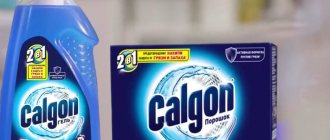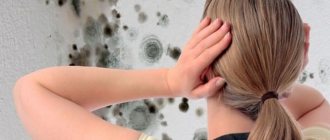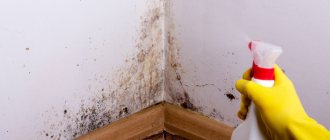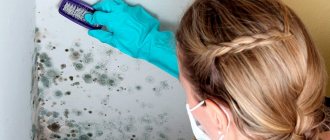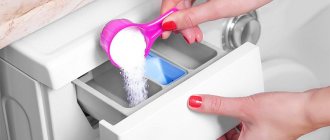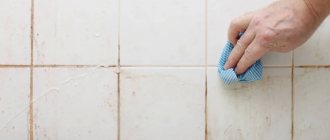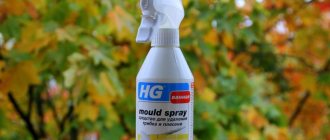Cleaning off mold on the rubber band of a washing machine is not as easy as it seems: conventional cleaning products cannot cope with fungal deposits. But don’t rush to the store for expensive sprays and “special purpose” liquids, because you can make them at home, spending 10 or even 20 times less money.
Professional and folk remedies for cleaning rubber bands in the washing machine
The doors of front-loading washing machines are equipped with rubber bands. The part serves as a reliable seal and seals the drum, which is filled with water during washing.
Like all other parts of the automatic machine, the rubber seal requires periodic maintenance. You will learn how to properly treat the protective cuff and extend its service life here.
Why do you need to clean?
The rubber seal has a complex design with bends and folds. Dirt, hair, lint and debris accumulate in large quantities in the folds of the cuff - everything that was not removed through the filter and drain hose.
Due to the configuration, the rubber constantly maintains high humidity , which serves as an excellent environment for mold.
Attention! The remains of garbage are subject to rotting and mold infection, unpleasant odors and black spots appear - colonies of fungi and bacteria.
The musty smell not only creates an unfavorable atmosphere in the room, but also permeates washed clothes. Therefore, a responsible housewife should not have any questions about why the rubber band needs to be cleaned.
Causes of unpleasant odor and fungus
The unpleasant odor of the seal appears for the same reasons as in the drum of the unit:
- Incorrect installation of the device - if the machine is placed on the floor at an angle, the water does not completely drain out of the pipes.
- Abuse of low-temperature washing mode - the insides of the machine cannot be disinfected with hot water.
- Inadequate care of parts and detergent container.
- Refusal to use anti-scale agents and powders with bleaching properties.
- If the device door is constantly closed, the drum and rubber band do not have time to dry out, but remain wet.
- Storing dirty laundry in a “washing machine”, where bacteria multiply intensively and a stench appears.
- Lack of preventive cleaning of the washing machine - inside and outside the body.
- Incorrect use of rinse aid - it must be washed off with a double rinse, otherwise an oily residue remains, ideal for fungus.
Important! Poor water quality is one of the causes of odor and mold. It is recommended to use water softeners that will fight limescale on the gum.
Where does it appear most often?
To be able to detect the fungus in time, you need to know its favorite locations:
- under the rubber seal around the loading door;
- tray for washing powder and conditioner, as well as the space under and around them;
- a hose through which detergents enter the drum;
- dirty water drainage hose;
- filter.
Mold on the rubber seal of the washing machine
All of the above places where fungal plaque first appears should be inspected periodically. If mold is discovered, it must be removed immediately. But the fight will not be effective unless the causes are identified and eliminated.
Why is this dangerous?
Mold on various surfaces of the washing machine is not only an aesthetic problem. In addition to the plaque and disgusting smell that is unpleasant to the eye, such a neighborhood poses a considerable danger to human health:
- Mold spores spread very quickly. Therefore, if it is discovered that the sealing gum has slightly blackened, you need to immediately begin the fight. If this is not done, plaque will appear not only on the drum, but also on the external surfaces of the machine.
- The appearance of mold in any household appliances is not a local problem. The spores quickly spread throughout the bathroom, and very soon you will find it in the seams between the tiles, on the ceiling, and on the walls.
- If there is mold in the drum, clothes washed in the machine will smell not like powder or conditioner, but like mold.
- Rooms where mold grows always smell damp.
- Mold not only smells and looks unpleasant, but also destroys the structure of things and parts.
Choice of product
A variety of household chemicals are suitable for caring for the sealing cuff of an automatic machine. It is important that they not only have bleaching, deodorizing and cleaning properties, but also be able to cope with mold and bacteria.
Baking soda
Use soda to clean the cuff manually - a self-prepared gruel or soap solution will do. In the first case, 2-3 tablespoons of soda are combined with a small amount of water to obtain a paste.
Apply the product to a kitchen sponge and wipe the gum around the entire perimeter, carefully treating the inner surface.
The second option is to mix a spoonful of baking soda with gel or dishwashing liquid . A soap solution works in the same way - apply to dirt and scrub thoroughly. You need to let the soda act for a while (about half an hour), and then rinse off the remaining substance with clean water.
Important! During the washing process, it is forbidden to stretch the elastic band too much, otherwise the seal of the automatic machine will be broken.
Antibacterial and chlorine-containing agents
This group of products includes household chemicals containing disinfectant additives to eliminate bacteria, viruses and mold. They do not have to be designed specifically for the washing machine.
Universal products for caring for plumbing fixtures, tiles, and work surfaces in the kitchen are suitable:
- “Toilet duckling”;
- “Domestos”;
- Sanfor;
- Neomid;
- Cillit Bang;
- Mildew remover;
- Veksa;
- Vanish.
Advice! Choose the release form that is convenient for you - spray, gel or liquid. The drug is applied to the gum with a washcloth or a damp cloth, and after 30-60 minutes it is washed off along with the dirt.
Copper sulfate
Copper sulfate pentahydrate is especially popular among summer residents for controlling pests of trees and shrubs. In everyday life, the antiseptic, antifungal and disinfectant properties of the liquid are also useful.
How to wash properly:
- Prepare a cleaning solution - 30 g of substance per 1 liter of clean water.
- Soak a rag or washcloth in the liquid and treat the cuff without missing a centimeter.
- Leave the drug to “work” for about a day.
- After a day, turn the machine on to the quick wash mode.
- At the end of the process, wipe the gum dry and leave the door open so that the surfaces are completely dry.
Fighting methods
You can get rid of mold in your washing machine using store-bought and homemade products. The former act faster and often more effectively (due to the content of aggressive chemical components). Some folk recipes cannot handle serious damage, but if the scale of the problem is small, start with homemade formulations.
Store-bought household chemicals
Every day the market is replenished with new offers with improved formulas
But can all manufacturers be trusted? In order not to spend large sums of money searching for “that” cleaner, pay attention to the rating of proven and popular products
Table 1. Ready-made chemicals
| Name | View | Manufacturer country | Mode of application | Volume, ml | price, rub. |
| "Domestos Universal" | Gel | USA | Apply to the drum, wipe the cuff with a sponge soaked in the product. Leave for 4 hours. Then turn on the rinse mode, followed by a wash at 90° adding citric acid to the tray | 1 000 | 120 |
| "White" | Liquid | Russia | Pour as much bleach as possible into the compartment (the entire bottle) and run a long wash cycle at high temperature. After 2 hours of work, pause (1.5 hours). Continue washing by adding a liter of vinegar to the rinse aid compartment. | 1 000 | 35 |
| "Deo-anti-mold" | Liquid concentrate | Russia | For 5 liters of water, 0.5–1 liter of concentrate is required (treat heavily affected surfaces without diluting). | 1 000 | 170 |
| Cillit Bang | Foam | Great Britain | Removes black mold in 15 minutes. Spray inside the drum, after a quarter of an hour, wipe with a washcloth, turn on the wash | 750 | 300 |
| Neomid | Antiseptic concentrate with water in a ratio of 1:20. | Russia | Antiseptic helps in advanced cases. Apply to problem areas, rinse after 40 minutes | 500 | 535 |
| Savo | Spray | Czech | Eliminates and prevents the appearance of fungus and mold. The active substance acts for 15–20 minutes, then it is washed off with water | 500 | 160 |
| Astonish Mold Mildew | Aerosol | England | The method of application is similar to the previous one | 750 | 270 |
Advice. Using any store-bought mold remover, after the procedure, wipe the tank with a dry cloth and leave the door open for 2 days so that the machine is well ventilated. Wear gloves when handling chemicals.
Home Recipes
On home economics forums you can find many stories about fighting fungus with folk remedies. But if you do not want to join the ranks of word of mouth participants, use ready-made, and most importantly, proven recipes.
Vinegar
Vinegar helps get rid of fungus in the machine by removing salt deposits. Do not use natural apple and grape compositions that may contain dyes and oils - marks will remain on the machine parts. The best option is 9% table vinegar.
Additionally, pour vinegar into the drum itself
Pour 150 ml into the powder compartment, select the maximum temperature and washing mode. When you start spinning, pause it. To eliminate mold, 30 minutes is enough, for limescale – 1.5 hours. After waiting the required time, unpause and complete the cycle. At the last stage, remove and clean the outlet filter, treat the seals, drum, and powder tray with a vinegar solution (50 ml of concentrate per 1,000 ml of water).
Soda
Soda is relevant in cases where minor manifestations of fungus are involved. Prepare a slurry by adding water, and treat the seal lip, drum surface, and cleaning agent bins with this mixture. As a tool, use a toothbrush (for hard-to-reach parts), thin brushes, and dish sponges.
Keep the composition for half an hour to an hour. Finish the process by adding washing powder (1 tbsp) to the tray and starting the machine. At the end of the wash, pull out and dry the outlet filter, wipe all surfaces dry, and ensure the drum is ventilated.
Lemon acid
A safe remedy in the form of a lemon helps remove mold from your car. The effect will be noticeable if the fungus has affected small areas. More often, acid is used as a preventative cleaning once every 3 months or to eliminate musty odors.
For best results, run the machine twice with lemon juice.
Pour 250 g of lemon into a dry powder container and turn on the longest washing program. In this case, there is no need to pause. After the end of the cycle, repeat all the usual steps of removing the filter, wiping parts, rubber, and drum. Do not close the hatch or door until the machine is completely dry.
Rules for cleaning the sealing part
Mold is not the only problem that housewives face when caring for the unit. The washing machine may show signs of rust, limescale , dirty spots and an unpleasant odor. We will now tell you how to deal with each of the problems.
How to remove dirt and stains?
Debris and dirt most often accumulate in the internal space - it is necessary to unscrew the cuff and remove all foreign objects. It is most convenient to do this with a gloved hand and a small washcloth or rag, which can easily penetrate into a narrow space.
Then apply any of the chlorine-containing products (“Domestos”, “Utenok”, etc.) to the same washcloth and treat all parts of the rim. Then close the door of the unit so that the drug works better. After half an hour, complete the procedure by washing with clean water and wiping dry.
Soda gruel also works well with dirt stains - a soft abrasive helps to scrub away stubborn dirt without the risk of damaging the surface.
Important! In advanced cases, you will have to dismantle (remove) the cuff in order to thoroughly disinfect and remove dirt.
From plaque and rust
Not only plumbing fixtures and faucets suffer from limescale deposits, but also washing machines. You can fight plaque with citric acid - place 2 tablespoons directly into the drum and wash on the longest cycle.
Acid removes deposits not only from the seal, but also from the drum with the heating element.
Anti-lime tablets for dishwashers are also suitable for caring for washing machines . It is enough to place 5-6 tablets in the drum and “scroll” the unit idle at high temperature.
Rust does not form on the rubber itself, but along its perimeter on the metal body of the device. But it is also necessary to fight it, otherwise more extensive cracks and stains will appear.
Acetone or nail polish remover will come to the rescue:
- Use a damp cloth to remove visible dirt and rust particles.
- Apply acetone to a cotton pad or a piece of dry cloth and spot treat problem areas.
- Leave the solution on the surface for approximately an hour.
- Turn on the single rinse mode at a temperature of at least 60 °C.
- After rinsing, wipe the rubber seal dry and leave the device to ventilate.
From an unpleasant odor
Housewives manage to eliminate unwanted aromas and eliminate the cause of their appearance with the help of ordinary “Whiteness”.
Instructions for use:
- Pour 1 liter of bleach into the container under the powder.
- Turn on the machine, having previously selected high temperature mode and double rinse.
- Half an hour after the start of washing, the machine is paused for 2-3 hours.
- The unit is started again, and at the moment the rinsing begins, 2 cups of 9% vinegar are poured into the powder tray.
- When the machine finishes washing, wipe the cuff dry and leave the door open.
Substances with intense aroma and disinfectant properties will help get rid of the smell. The rubber band can be wiped:
- natural lemon juice;
- eucalyptus essential oil;
- rosemary, pine or basil oil.
Advice! Another effective option is to pour a couple of tablespoons of lemon juice into the container under the detergents and start the rinse mode at a temperature of 40 degrees.
If it turns black
Method No. 1. Regular table vinegar will help fight mold and at the same time clean the washing machine parts from plaque and dirt.
How to clean:
- Dilute vinegar with water in proportions of one to one.
- Pour the resulting solution inside the cuff - a couple of measuring cups are enough.
- Select the longest wash cycle at high temperature.
- 10 minutes after the start of washing, pause the unit, and after 2 hours start it again.
- Continue working and finally wipe all the insides with a dry cloth.
Important! This method can be used no more than once every 6 months, since the acid can destroy the rubber parts of the device.
Method No. 2. In case of extensive mold damage to the gum, you will need a solution of peroxide and vinegar. Take pharmacy peroxide with a concentration of 3%, vinegar - table vinegar, 9%.
Instructions:
- Mix vinegar and peroxide in equal proportions and place in a spray bottle.
- Wipe the dirt on the cuff with a damp cloth.
- Spray the solution over the entire rubber band, stopping at the most problematic areas.
- After 10 minutes, go through the dirt again with a washcloth or rag.
- Wash off dirt and remaining solution with a rag soaked in clean water.
Method No. 3. Monarda extract has antibacterial and fungicidal properties - this liquid dietary supplement can be purchased at the pharmacy.
To clean the gum, combine 15 ml of extract with 200 ml of cool distilled water. The solution is poured into a spray bottle and sprayed onto the sealing ring. The product does not require rinsing with clean water.
This is interesting: how to descale a washing machine, read here.
What are the reasons for the appearance?
The main consequences of mold: the appearance of dark spots on the sealing rubber and the unpleasant smell of mold in the washing machine drum, which is subsequently transferred to the washed items.
Mold cannot be ignored, as it is a direct breeding ground for various diseases. Several common causes of mold and mildew:
Washing clothes at low temperatures . This is strictly prohibited; it is better to alternate both operating modes and the temperature threshold.- Remaining water inside the drum . Liquid can remain in the washing machine only if its drainage system is not properly maintained and is clogged. A simple button causes constant moisture in the drum.
- Unclosed door . The seal not only prevents water from leaking out during washing, it also prevents air from entering the machine after the process itself. A little liquid and excess oxygen are a favorable environment for the appearance of harmful microorganisms.
Leaving water in the drum even once can lead to rapid mold growth. Therefore, the washing machine requires constant care and periodic inspection.
Mold Prevention
What you need to do to prevent mold from appearing:
- Do not leave the machine door closed in standby mode;
- wipe the cuff dry after each wash cycle;
- do not overuse rinse aids;
- carry out periodic preventative washing “idle” with citric acid and bleaching powders;
- use softeners for hard water;
- wash at high temperature at least once a month;
- remove blockages in a timely manner and remove debris accumulating in the cuff;
- check pockets of clothes before putting them into the drum.
You should not forget about cleaning the rubber seal - this is one of the most problematic areas of the washing machine.
A dirty cuff serves as a source of bacteria and fungus, which negatively affect the hygiene of the home and the health of its inhabitants.
Drain hose
In case of blockage and to prevent stagnation, you should periodically rinse the flush hose. Need to:
- Use chemicals. It is better to purchase a specialized product at any hardware store. The product is poured into the tray and washed without clothes.
- Carry out dismantling. The hose is removed and then cleaned by hand. Then they are installed in place.
You can remove dirt and debris from the drain filter as follows:
- Unscrew the filter. Before doing this, place a container nearby to drain the accumulated liquid.
- Perform cleaning. The machine is tilted over the container until the accumulated moisture is completely removed. Remove debris from the filter by hand, and wash the filter itself under running water.
- Reinstall the filter. To consolidate the result, it is better to conduct a test drain by setting the appropriate mode on the display of the household appliance.
Useful video
How to quickly and easily clean your washing machine:
The area around the door of a front-loading machine is an ideal breeding ground for germs. Accumulations of dirt, mucus, and foam residues settle on warm, damp rubber, where mold is successfully cultivated within a few days.
From dirt and stains
Black traces of fungus are a consequence of improper care of the washing machine. Gray plaque is easier to remove:
- Use a damp cotton cloth to remove dirt from accessible areas of the seal.
- Protect your hands with household gloves.
- Take out the inner surfaces of the elastic by bending the edges.
- Wash both sides of the cuff with a sponge soaked in Domestos.
- The door is left closed for 20–30 minutes.
- Turn on the drum cleaning mode.
- Wipe the seal dry and ventilate the drum until the next wash in the open state.
From plaque and rust
Rusty stains form along with black stains, growing intensively along the perimeter of the rubber band. Remove plaque with a solvent.
The best way is acetone nail polish remover:
- Ensure hand safety and pay attention to ventilation.
- Mechanically remove the layer of dirt with a napkin.
- The solvent is applied pointwise to the affected areas.
- Leave for an hour.
- Wash using rinse mode at a temperature not lower than 60 degrees.
From an unpleasant odor
The moldy aroma of rotten water will go away along with bacterial contamination.
When you only need to remove an unpleasant odor, use lemon:
- The zest is turned into thin shavings.
- The juice is squeezed out of the pulp.
- Strain from seeds and plant fibers.
- The shavings are placed in a laundry bag.
- Place inside the drum of the machine.
- Lemon juice is applied to the sealing gum, the insides of the drum, 2 tablespoons are poured into the tray.
- Start the rinse mode with a water temperature of 40 degrees.
- Wipe dry, ventilate.
From mold and mildew
Monarda extract will help clean the washing machine seal from germs. The product is sold in liquid form in pharmacy chains as a dietary supplement.
- A bottle of extract will last a long time. 15 ml are diluted in 200 ml of cool distilled water.
- Apply to the areas to be cleaned by spraying.
- No need to rinse off.
The disadvantage of the solution is a specific odor that quickly disappears.
How and with what to clean the rubber seal in the washing machine drum
The seal can be washed using different types of home and professional chemicals.
Before cleaning the rubber band in the drum of the washing machine, you need to empty the standard or top-loading machine from the laundry, put on gloves and inspect the unit. The cause of contamination may be mold, scale, rust, or limescale. Black mucous stains are accompanied by an unpleasant odor; it is not always possible to remove stains with homemade recipes.
From mold
Mold on car rubber can be cleaned using a vitriol solution. For 20 g of cleaning agent for washing appliances, 1 liter of water is used. To prepare the product, you need to take a glass jar, pour hot liquid into it, and add the required amount of powder.
Vitriol should not be diluted in metal or enamel containers.
Clean the entire seal with the prepared solution, leave the washing machine for a day to dry completely, and thoroughly wash the rubber with dishwashing detergent. This method is suitable for units whose seal is slightly dirty. You can completely remove mold from a part by removing the cuff and treating the machine body underneath it.
The washing cuff is attached to the body with snap clips. You need to pull them, remove the rubber, treat it with cleaning powder in a basin of warm water. Clean and wipe the area under the mechanism element. Dry the cuff with a dry cloth or paper towel.
We invite you to familiarize yourself with the High-pressure car wash device
Some machines have a different principle for attaching the cuff. Before dismantling the part, you need to study the instructions for the device in detail.
A good substance to clean rubber washing seals is monarda extract. The drug can be found at the pharmacy. The product is diluted in distilled water (for 15 ml of monarda - 200 ml of liquid), poured into a spray bottle, and applied to the dirt without rinsing.
After using any composition, you will need to run the automatic washing machine for a long program at maximum temperature (95 degrees); after completing the cycle, you need to wipe the drum dry and leave it open.
From scale
Rubber can be descaled using household chemicals or folk recipes.
Store-bought products have one drawback - they spoil the parts. Substances should be used only in extreme cases, following the instructions.
The automatic machine needs to be cleaned with citric acid every four months:
- pour 100 grams of product into the washing powder compartment;
- set the mode to high temperature;
- We start a long washing program without laundry.
The method is good for preventing the formation of scale in the car and slime on rubber.
Vinegar solves the problem of mold and salt deposits. They can be used to clean the seal of the washing unit and remove unpleasant odors:
- pour two glasses of vinegar into the laundry compartment;
- put on a long wash, select the maximum temperature;
- after five minutes you need to pause the mode for an hour;
- unpause the machine and wait for the wash to finish;
- run a short program;
- clean all parts of the washing device with a paper towel or dry cloth;
- leave with the door open until the rubber is completely dry.
Dampness and mold are the consequences of poor washing machine care. It is important to determine the location of the odor. If it is not clear where the smell comes from, you should call a professional to identify the cause.
It is recommended to clean the rubber in the drum using household chemicals containing non-aggressive chlorine. A recipe made from vinegar and citric acid will do.
Sometimes scented washing powders can help get rid of unpleasant odors in your car. This method only masks the problem.
You can clean rubber using dishwasher tablets. 6 pieces are poured into the drum, a long mode is started at maximum temperature, and in the middle of the cycle they pause for three hours. If your machine does not have this function, you can unplug the plug from the socket. After 3 hours, washing is resumed. It is recommended to run an additional rinse mode.
Baking soda
If you don’t have hydrogen peroxide and citric acid at home, then there is another way to get rid of mold on the rubber band of your washing machine - baking soda. To prepare the solution you only need one teaspoon of the ingredient. This amount of baking soda must be diluted in one glass of water at room temperature. Do not make the solution more concentrated, otherwise it will damage the enamel or paint applied to the equipment.
Next, use the resulting liquid to wash off the mold on the rubber band of the washing machine. This can be done using a household rag or dishwashing sponge. After the procedure, the surface of the seal must be wiped with plain water.
Clean the car under the rubber
The following solutions will help effectively remove contaminants in hard-to-reach areas of the seal and under the cuff:
- Copper sulfate is diluted at the rate of 50 g per 2 liters of softened water.
- The sealing ring is filled or sprayed with the resulting liquid.
- Lasts for 6–12 hours.
- Rinse and wipe dry.
After taking copper sulfate, mold will not return soon.
For complete cleaning, it is important to know how to clean the filter in a washing machine.
Complete washing machine cleaning
Comprehensive measures for cleaning rubber in a washing machine are the most effective. This means that it is most effective to remove dirt not in certain areas, but throughout the entire device:
- Check and wash the filters.
- Dry the hoses.
- Treat internal accessible parts of the structure with antiseptics.
- Run the drum cleaning mode once a month.
Only complete cleanliness guarantees long-term operation of the machine without the need to replace parts, repairs, or unscheduled service diagnostics.
Tips for caring for your machine
High humidity, a warm environment, and an abundance of contaminant residues give rise to the rapid growth of fungus and the appearance of a putrid odor.
General operating rules will help to postpone problems with contamination of a household appliance for a long time:
- Once a month, run a full wash cycle with laundry at a temperature of at least 60 degrees.
- Do not overuse rinse aids and foam additives.
- Remove clean items from the drum immediately after washing.
- The machine door is kept open between jobs.
- Carefully wipe off moisture from the seal.
- Use bleach once a week when washing.
- Softens hard water.
Carefully studying the instructions for using the washing machine and following the service advice are guaranteed to prolong the uninterrupted operation of the device.
Mildew remover for washing machine
Mold is afraid of high temperatures, so it is very important to clean the machine at maximum washing degrees.
An unpleasant-looking black coating that affected the insides of the first assistant in the household can puzzle any woman for a long time. That is why the question of how to remove mold in a washing machine always comes first. You can get rid of fungus by using products containing acids, chlorine, maximum temperatures and completely drying the device. What does this procedure look like?
- First you need to remove the mold using citric acid, which is applied to a sponge and thoroughly wiped with it over the entire surface of the machine. Be sure to leave the product for a while for it to work, and then carefully rinse off.
- The rubber rim near the door must be treated with an aqueous solution of copper sulfate, which has an excellent ability to destroy harmful microorganisms and fungi. It should be left applied for a day, then rinsed with water.
- When deciding how to remove mold, do not forget that it is afraid of high temperatures. Therefore, it is important to run this washing mode in order to wash the fungus from the machine.
- You can clean the unit with baking soda, which has the necessary abrasiveness and does an excellent job of removing fungus.
- At the end of the treatment, it is important to include a rinse to remove all detergents.
- Remember! It is important to let the car dry thoroughly to prevent the fungus from reoccurring.
What to do if the smell remains?
With severe infection, it happens that the fungus itself has already been destroyed, but its microparticles continue to emit a specific odor. What can be done in this case?
First, clean your carpet thoroughly if you haven't already. Once properly cleaned, there will be no stinking mold particles left behind.
Secondly, odor residues can be removed with sorbents. These are substances with good absorption capacity:
- Soda. We take more ordinary dry baking soda and scatter handfuls of it over the surface of the carpet in a more or less uniform layer. There is no need to walk on it and there is no need to scrub it with a brush, we just leave it until the next morning. Then we vacuum. If the smell remains, repeat the treatment again. For difficult cases, you can mix dry soda with borax (you can find it in any pharmacy), the ratio is approximately 1:1.
- Industrially produced sorbent. There are special moisture and odor absorbers available in the form of granules. We use them the same way - scatter them on the carpet and collect them in a day or two. If it is difficult to find such an absorber, you can buy regular cat litter. This is an equally effective sorbent, because its direct task is to absorb liquid and odor.
- Charcoal. Sold in supermarkets, intended for use in the grill or barbecue. In our case, it needs to be crushed and poured into old stockings or tights. Place the filled stockings on the carpet in one direction and roll it up. The more coal you put in, the better the effect. Leave the rolled roll for a day or two in a warm and dry place. Then unwrap and vacuum well. If necessary, repeat again, but use new coal.
Cleaning products
The reasons for damage to the washing machine seal are hidden in the design features of the machine. High humidity, low-temperature washing, abuse of rinse aids, refusal of bleach, rare use of anti-scale agents lead to the formation of a favorable environment for the growth of fungus, bacteria, and accumulations of limescale.
Professional
At the initial stage of the formation of a musty smell, it is enough to run a full laundry cycle. Concentrated powder with bleach will easily eliminate signs of gum deterioration. If black stains are already noticed on the sealing insert, specialized household cosmetics are suitable for removing contaminants from the affected parts of the machine.
Chlorine-based bleaches are a popular alternative to expensive formulations:
The properties of chlorine to kill the microbial environment will allow you to destroy bacterial plaque, prevent its spread, and prevent relapse.
- Concentrated washing powder, containing bleaching granules, helps neutralize microorganisms. With regular use of phosphate detergents, at a temperature of at least 60 degrees, there is no need for additional disinfection of the drum, seal or tray.
- Manufacturer from Japan “Kaneyo” will ensure getting rid of scale, dirt, rust, and fungus. The series is designed for advanced cases, eliminating traces of damage to internal tubes and hoses; will effectively clean the rubber seal in the idle wash mode.
- Tablets are a compressed, concentrated form of fungal control. Contains chlorine or natural biocomponents of plant origin. Among the list of verified ones are “RENE” , “Faberlic” , “Frau Schmidt” .
- There are specialized powders for cleaning washing machines and dishwashers. The Dutch company “HG” guarantees a high-quality victory over mold spores, prevention of the appearance of mucus, and cleaning of the drum from scale particles, dirt, and microbial environment.
Professionals urge you to use specialized products and not experiment with acids, Whiteness , or Coca-Cola .
Folk
To wash away the remnants of alkaline plaque, which form mucus and create favorable conditions for bacterial growth, an acidic environment is used. Practice-tested methods for eliminating mold, plaque, and dirt are used:
- Vinegar 9% is diluted with cooled boiled water in a ratio of 1:3. This solution is used to wash at idle speed, mechanically clean the rubber in a washing machine, and treat the powder tray.
- Citric acid is poured directly into the compartment instead of powder. For 5 liters of loading, 10 g of crystalline lemon juice is enough. If there is a need to remove yellowness from nylon tulle, the processes are combined.
- Hydrogen peroxide removes fungal colonies. The treatment is carried out without diluting the solution. There is no need to rinse off after application. Use a swab soaked in the product to remove dirt, wipe dry, and apply peroxide again.
- Boric acid in the form of a solution: 10 g of powder per ½ liter of boiled water. The mixture is heated until the precipitate is completely dissolved and cooled. They act in the same way as in the recipe with peroxide.
- Essential oils in high concentrations will negatively affect plastic and rubber. Follow the norm: for 5 liters of liquid no more than 3-4 drops of pure oil. Mix 2 drops of tea tree oil with 2 drops of lemon or rosemary oil. Pour into the rinse aid compartment with neutral liquid soap or baby shampoo. The operation, repeated from wash to wash, serves as a prophylaxis against microorganisms.
We use essential oils
We are talking about real essential oils, and not about cheap scented substitutes.
The latter do not have antiseptic properties and can only temporarily suppress the smell of mold with their aroma. The most popular and effective antiseptics among essential oils are tea tree oil and grapefruit seed oil. Choose what you like best, because the aroma of the product will hover in the room for at least several days. What do we have to do:
- Take a spray bottle and pour a glass of cold water into it.
- Add a tablespoon of tea tree oil or 10-15 drops of grapefruit oil to the water.
- Close the container and shake well. You need to shake immediately before spraying, as the mixture quickly separates.
- Spray the solution onto the infected areas of the carpet.
- Wait until the pile dries. There is no need to rinse off the product.
Cleaning Rules
To prevent mold from developing in the machine drum and a rotten smell from appearing, you must keep the door ajar. Also, after washing, be sure to rinse the powder tray of any remaining detergent. Wipe it with a dry cloth, and also wipe the connector where this tray is inserted. However, let's return to the drum rubber and tell you how to clean it.
- Use a damp cloth to remove mold and other deposits from the outside of the gum.
- Fold back the edges of the cuff and wipe the inside, where mold usually grows.
- Soak a sponge in bleach or another chlorine-containing product.
- Wipe the inside and outside of the gum with a sponge, as well as the surface of the drum. Particular attention should be paid to the grooves of the cuff, applying more product.
- Close the drum and leave the machine for half an hour.
- After disinfection, you need to run the rinse mode to rinse the drum and rubber band of detergent.
You can effectively clean the cuff from mold with a solution of copper sulfate diluted in a proportion of 30 g per liter of water. It is enough to apply a small amount of solution to the cuff, wait about a day, and then rinse with water and wipe with a dry cloth. You can run the machine in the “Fast 30” mode so that the remaining substance is thoroughly washed out.
You need to wash the elastic band of the cuff and remove excess moisture from it after each wash; if you keep the cuff clean, you won’t have to clean it. Even if mold appears, you will clean it much less often.
If too much mold and debris has accumulated under the cuff, you will have to remove it completely . This is not difficult to do; the whole process is described in the article on how to replace the cuff on a washing machine. This has its advantage, because this way you can completely and more thoroughly rinse the rubber in a basin in a large amount of water, then dry it and install it back. And if it is damaged, then replace it with a new one.
Drum
You can clean the drum using any of the methods described earlier. An excellent result is guaranteed by the use of ready-made products, for example, Frisch Active. All such products require following a certain algorithm:
- the product is poured into a measuring cap;
- half of the liquid is poured into the powder tray, and the second into the drum itself;
- start washing at a temperature of 70 degrees without laundry, avoiding draining the water;
- at the end of the cycle, leave the solution in the machine for at least 30 minutes, then start draining;
- turn on the rinse mode, then drain the water again.
The latest models of machines have a special program that allows you to clean the drum from grease, mold and scale. In this case, the procedure is reduced to pressing a few buttons.

